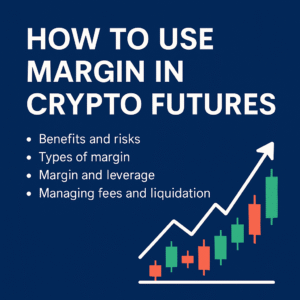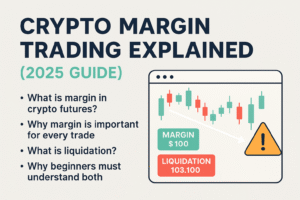Crypto leverage trading has surged in 2025 as more people seek ways to boost returns without tying up large sums.
By borrowing funds from exchanges like Binance, Bybit, BingX, and MEXC, traders can open much larger positions than their account balance normally allows. This approach can turn small price moves into significant gains, but it also amplifies losses when the market shifts against you. Understanding leverage inside out is essential for anyone who wants to navigate futures markets safely and profitably.
What does high leverage really mean?
High leverage lets you control a position that’s many times larger than your own funds. For example, 10x leverage means a $100 deposit opens a $1,000 trade. If the market moves up by 5%, you earn $50, or half your deposit. But if prices drop by 5%, you lose that same $50 instantly. At 100x leverage, even a 1% swing wipes out your entire hold, turning small fluctuations into all-or-nothing outcomes.
Why new traders get attracted to it
Social media and trading forums brim with screenshots of massive gains achieved in minutes. Learning curves feel steep, so many beginners see leverage as a fast track to wealth. Limited capital no longer seems a barrier when you can borrow 50x or 100x your funds. Without a clear plan or stop-loss in place, newcomers often bet the farm on one trade and find their balance erased within seconds of a sharp move.
What this guide will honestly tell you
This guide cuts through the hype to deliver clear, practical advice. You’ll see exactly how 10x and 100x leverage work, complete with real 2025 examples and profit-loss scenarios. We’ll compare top platforms’ fees, tools, and safety features. You’ll also learn proven risk controls—stop-loss placement, position sizing, and margin mode selection—that help you grow your account steadily. Trade smart, not just fast, by using leverage as a controlled tool rather than a gamble.
Why Beginners Use High Leverage
Many new traders jump into high-leverage trades because they want to turn a small deposit into a much larger position. When you see that $100 can control $10,000 with 100x leverage, it feels like a shortcut to serious profits. In 2025’s fast-moving crypto markets, this “small money, big trade” angle captures attention quickly. It removes the need to save up large sums and makes trading feel accessible to anyone with a modest budget. Yet that same feature also magnifies every mistake, so excitement often leads to costly errors.
Stories of fast profit on YouTube and Twitter
Social media constantly showcases traders who doubled or tripled their accounts in minutes. YouTube influencers post chart screenshots and tweet about 20x returns from single trades. These success stories spread like wildfire, creating immense FOMO among viewers. When beginners see others celebrating massive gains from leverage, they assume the strategy works for everyone. Behind the scenes, however, many of those accounts crumble after a few losses—accounts that never make it into the highlight reels.
Copying pro traders without knowing the risks
Copy-trading services on platforms like BingX and Bybit let newcomers mimic high-leverage strategies used by top-ranked traders. It seems safe to follow someone with a proven track record, but few beginners understand the underlying risk parameters those experts apply. Pro traders may use tight stop-loss rules, position sizing, and isolated margin to protect themselves—techniques that novices often overlook. Copying a strategy without grasping its risk controls can wipe out a copied position before the beginner even realizes what went wrong.
Real Dangers for New Traders
Leverage can seem like a magic wand for quick gains, but it also comes with serious hazards—especially for those just starting out. In 2025, crypto markets remain highly volatile, and traders who don’t understand the risks often find themselves on the losing side of big price swings. Before you use high leverage, it’s vital to know exactly how fast things can turn against you and why most beginner accounts don’t survive.
Just 1% drop can liquidate your position
When you use high leverage, your margin cushion shrinks dramatically. For example, at 100x leverage, a mere 1% drop against your entry price wipes out your entire margin and triggers automatic liquidation. Even at 10x leverage, a 10% adverse move can close your position. Because crypto often moves in sharp, unpredictable bursts—driven by whale orders, news headlines, or network events—even small dips can destroy a trade in seconds. Without proper stop-losses or quick reactions, your account balance can vanish before you blink.
Why most new accounts go to zero
New traders often risk a large share of their funds on a single high-leverage bet. They see big gains in highlight reels but ignore the countless losses behind the scenes. Without a clear risk plan, they either skip stop-loss orders entirely or set them too wide. Many also use cross-margin and let one bad trade bleed through their entire wallet. Combine that with emotional decision-making—chasing losses or FOMO entries—and it’s no surprise that most inexperienced accounts end up at zero.
2025 data: Over 70% of new traders lose with high leverage
Industry reports and on-chain data from Q1–Q2 2025 show a striking trend: more than 70% of new futures traders using over 20x leverage lose at least 50% of their margin within their first ten trades. Exchanges such as Binance and Bybit publish regular liquidation stats that highlight massive drops during jumpy market periods. This data makes one thing clear—high leverage magnifies small mistakes into account-ending events. If you’re new, the odds are stacked against you unless you practice strict risk controls and start with very low leverage.
How Liquidation Works
Liquidation happens when your leveraged position loses enough value that the exchange must close it to protect its loan. In simple terms, if your margin falls below the required maintenance level, the platform shuts your trade automatically. This prevents you from owing more money than you deposited but also means you lose your margin in full.
What is liquidation? Easy explanation
Liquidation is like an emergency brake for your trade. When you open a leveraged position, you deposit a small amount (your margin) and borrow the rest. The exchange sets a maintenance threshold based on your leverage level. If market moves push your margin below that threshold, the exchange cancels your trade instantly. You don’t get to decide; the platform acts to stop further losses.
Example: 100x trade with $100 margin
Imagine you use 100x leverage with $100 margin on a $10,000 position. A 1% drop in price against you erases your $100 margin and triggers liquidation. In that split second, the exchange closes your trade before you can react. Even a tiny market wobble during high volatility—like a sudden whale order—can wipe out your position entirely.
How to check your liquidation price before entering
Before you hit “Buy” or “Sell,” use the platform’s liquidation calculator. Enter your entry price, margin amount, and leverage level. The tool will show the exact price at which liquidation will occur. You can also set your stop-loss just above that level to exit automatically before being liquidated. Always confirm this number to know your risk and adjust your trade size or leverage accordingly.
Is Any Leverage Safe for Starters?
Leverage can boost gains, but it also raises risk. For new traders, the safest path is to start with very low leverage levels. By choosing modest multipliers like 2x or 3x, you gain real experience without risking rapid liquidation. Over time, you’ll learn how markets move, how emotions affect decisions, and how to adjust your strategy before you consider higher leverage.
When is 2x or 3x better than 10x+?
Using 2x or 3x leverage gives you more breathing room for price swings. If Bitcoin drops 5%, a 2x position absorbs that move without wiping out your margin. With 10x, the same drop would liquidate you immediately. During uncertain periods—like around Fed policy announcements or major token unlocks—lower leverage helps you stay in the market and learn from price reactions instead of staring at an empty account.
How to test low leverage without big losses
Most exchanges offer demo trading or testnet accounts. Use these tools to practice opening and closing 2x or 3x positions without real money on the line. Track how your trades perform under different market conditions—bull runs, flash crashes, and sideways trends. Once you consistently manage risk and execute plans in demo mode, you’ll build the confidence to switch to real capital with minimal losses.
Using stop-loss to protect your trades
A stop-loss order acts as your safety net. Always set a stop-loss when using any leverage, even 2x. If you open a 3x trade on Ethereum at $2,000, placing a stop-loss at $1,980 limits your loss to 3%. This prevents emotional decision-making and protects your margin from sudden market spikes. As you gain experience, adjust your stop-loss levels and position sizes to match your evolving risk tolerance.
Advice from Pro Traders
Top crypto futures traders in 2025 agree that leverage can boost returns but also amplify losses. They stress that smart risk management beats chasing big multipliers. Below are their key insights on high leverage, why they steer clear of extreme levels, and why risk control matters more than leverage itself.
What top 2025 traders say about high leverage
Seasoned traders like “CryptoProfessor” and former derivatives head at a major exchange often point out that leverage is just a tool — not a strategy. They recommend using no more than 5x to 10x for most trades. According to them, consistent profits come from patience, precise entries, and strict stop-losses. These pros note that small, controlled gains add up over time, whereas betting on high leverage creates emotional stress and forces rushed decisions.
Why they avoid 50x and 100x
High-leverage trades above 50x or 100x are viewed by experts as short-term gambles, not investments. Pro traders mention that they avoid these levels except for rare, ultra-confident scalps. Even then, they use tiny position sizes and set very tight stop-losses. They explain that extreme leverage offers no edge if market liquidity dries up or if an exchange faces sudden technical issues. In their view, most losses in crypto futures come from overleveraging and ignoring market depth.
Leverage doesn’t matter if you don’t manage risk
“Leverage only multiplies your plan,” says a top U.S.-based algorithmic trader. “Without a risk plan, you’ll lose.” Pro traders emphasize that position sizing, stop-loss, and margin mode (isolated vs. cross) define success more than leverage number. They teach new traders to calculate their liquidation price, never risk more than 2% of capital per trade, and use low to medium leverage until they master their strategy. In their experience, risk discipline turns small gains into long-term wealth—while unchecked leverage leads to quick wipeouts.









